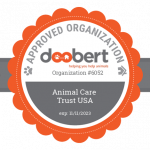 Recently, on All My Children Wear Fur Coats, Taylor Chastain Griffin illuminated the healing potential of cats, and explained how Pet Partners is working to enhance accessibility to therapy animals.
Recently, on All My Children Wear Fur Coats, Taylor Chastain Griffin illuminated the healing potential of cats, and explained how Pet Partners is working to enhance accessibility to therapy animals.
Taylor Chastain Griffin holds a Doctorate Degree in research psychology with a concentration on animal assisted therapy. She is the executive director of the Association of Animal Assisted Intervention Professionals (AAAIP), and the national director of AAI advancement for Pet Partners. Pet Partners is an international therapy organization that provides training and resources for volunteer therapy animals. The organization matches volunteers with suitable populations within their community, while providing liability insurance to handlers.
Taylor clarified the differences between therapy animals and service animals. She explained that service animals are trained to assist a single individual with specific needs, creating a 1-to-1 relationship with their handler. In contrast, therapy animals, while also trained, provide support and comfort to anyone they interact with in public, under the guidance of their handler. Additionally, service animals have legal rights to enter public facilities, while therapy animals require permission.
Although dogs are the most common service animal, they are not the only species that is eligible for service roles, especially therapy. There are nine different species at Pet Partners, including horses, lamas, alpacas, and pigs. According to Taylor, species are selected based on our understanding of their behavior, as well as our understanding of their zoonosis and infection prevention protocol.
One species gaining popularity in the field of animal therapy is cats. Taylor highlighted that cats are both under-researched and underappreciated in the context of therapeutic applications. She debunked some common misconceptions that lead the public to overlook cats’ therapeutic potential, pointing out the disparity between stereotypes and her research findings. While some cats live up to their standoffish reputation, many have personalities that are ideally suited for therapy. Taylor indicated that she has seen a growing demand for therapy cats, and she has been impressed by their impact on people.
When asked about what attributes qualify a cat to work as an emotional support therapy animal, Taylor stressed the importance of an outgoing temperament. She asserted that, regardless of species, sociability is more essential than any other characteristic. Therapy animals must have a strong bond with their handler, and they must be adept at recovering from stress. In addition, various practical considerations, such as an animal’s tolerance for travel, must be made to ensure the animal’s safety.
If you are interested in volunteering with your animal, please visit PetPartners.org. If you are a professional who is interested in bringing a therapy animal into your workplace, please visit AAAIPOnline.org
Make sure to protect your loved pet with a Pet Trust! Find out more at ACT4Pets.org!


